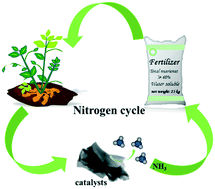A peanut shell-derived economical and eco-friendly biochar catalyst for electrochemical ammonia synthesis under ambient conditions: combined experimental and theoretical study†
Abstract
The electrochemical conversion of nitrogen (N2) to ammonia (NH3) under ambient conditions is a highly promising alternative to the energy-intensive Haber–Bosch process. However, it suffers from poor yields and selectivity because of the lack of efficient catalysts. Herein, we prepared an economical and eco-friendly efficient biochar catalyst from peanut shells and achieved a high ammonia yield (2.32 μmol h−1 cm−2) and selectivity (faradaic efficiency of 26.97%) over 12 h of stable operation. The results of density functional theory calculations illustrate that association pathways are more likely to occur on the active sites Bio-N4, Bio-O37, and Bio-S58, while dissociation pathways always occurred on the active sites Bio-O15, Bio-O21, and Bio-O52. Furthermore, Bio-O21 is the most promising active site for the NRR following the NNH2 dissociation pathway with a lower reaction barrier. The preferable adsorption of N2, desorption of NH3, and suppression of the HER demonstrated the peanut shell-derived material as a more promising catalyst for the NRR.



 Please wait while we load your content...
Please wait while we load your content...